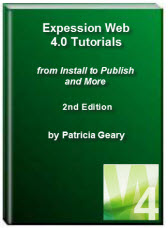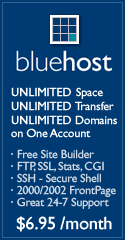- Home
- Expression Web Tutorials
- Installing Expression Web 4
- Setting Up Expression Web 4.0
- Create New Website
- Create a Blank Web Page
- Create a Webpage Layout
- Adding Horizontal Top Navigation
- Adding Vertical Navigation
- Validating Your Pages
- Creating an Expression Web Dynamic Web Template
- Publishing Your Web Site
- How to back up your local website on your hard drive
- SEO Checker and Report
- Adding Insert Include Code into Code Snippets
- Auto Thumbnail in Expression Web
- Broken Dynamic Web Templates and hidden metadata files
- Code Snippets in Expression Web
- Compatibility Checker on Status Bar in Expression Web
- Create and Style a Data Table
- Creating a New Font Family Group
- Creating a New Page from Hyperlink Properties
- Creating web site from site templates in Expression Web
- CSS Properties panel
- Expression Web Preview in Browser
- Expression Web and Design Time Includes
- How to back up your local website on your hard drive
- How to create a Personal Web Package
- Import Site Wizard in Expression Web
- Importing your folders/files into Expression Web
- Inserting Images in Expression Web
- Interactive Buttons in Expression Web
- Migrating a FrontPage Site to Expression Web
- Modify Style Dialog Box
- New Style Dialog Box
- Publishing Your Website from the Remote Server with FrontPage Server Extensions
- Editing Reusable Forms
- Troubleshooting Image Problems in Expression Web
- Validation Error - no attribute "xmlns:v"
- Web Album Generator and Expression Web
- What are all the style# in my page?
- Zoom Search and Expression Web
- Working With Left Border Background Images
- Resources
- Templates
- Web Design Tutorials
- Accessible Forms
- Add a Search Box
- Adding Google Search
- Accessible Data and Layout Tables
- Responsive Tables
- Anchor Tags and Name Attributes
- Best Font Size for Web Design?
- Center Page in Browser Window
- HTML Lists
- How to create and extract a Zip File in Windows
- How to Create a Self-Extracting Zip File
- Validation Error - no attribute "xmlns:v"
- Working With Left Border Background Images
- Handle Background Transparency in Snagit Editor Like You Would in Photoshop
- Bluehost Tutorials
- Add-on Domains at BlueHost
- BlueHost 301 Redirects
- BlueHost Webmail
- Customizing BlueHost Error Pages
- How to make a subfolder the main folder for your BlueHost main domain
- How to change the Primary Domain
- Installing a WordPress Blog Using Simple Scripts
- Mannaging SSL on BH
- Password Protecting Directories and/or Files with Bluehost
- Server Side Includes, BlueHost, and Expression Web
- Expression Web Addins

Google Web Fonts
 Cheryl Wise just offered a new template on her site Team Clueless Rally which made use of Google fonts for the fancy type used on the masthead and menu. Cheryl chose the Henny Penny font which you probably do not have available on your computer.
Cheryl Wise just offered a new template on her site Team Clueless Rally which made use of Google fonts for the fancy type used on the masthead and menu. Cheryl chose the Henny Penny font which you probably do not have available on your computer.
You can see an example of the title and tagline in the screenshot to the left. She achieves the look she wants because she used a Google Web Font that is called using a style sheet link that Google provided and added the font name to the css for the masthead and menu divs.
Quite often on websites I see fancy fonts used BUT unless your viewer has that particular font installed on their machine, the site will not display as intended. In the past, web designers have used graphic images to display fancy fonts they might want to use as part of the page design.
Since I really had not paid too much attention to Google fonts before, I decided to do some research to see how they worked.
Getting Started with Google Web Fonts explains how to use the Google Web Fonts API to add web fonts to your pages. You don't need to do any programming; all you have to do is add a special style sheet link to your HTML document, then refer to the font in a CSS style.
There are a huge number of fonts to choose from. Keep in mind that some fonts will be best used as masthead and menu text as Cheryl has done rather than use that font for your entire document.
Using Google Web Fonts
As an example, I decided to use one of the free templates offered on our sister site Default Site Template Project. This default template uses the following font family for the Site Name and Tagline.
font-family: "Palatino Linotype", Georgia, "Times New Roman", Times, serif;
We can spice it up a little by choosing a "fancier font" from the list of Google fonts available.
Step 1: Select the font you are going to use. NOTE: The hardest part may be selecting which of the many fonts to use. For this example, I chose Risque. Click 'Quick Use' on the right hand side of the page.
Step 2: Copy the code Google gives you to the head section of your page or template which is a link to the style sheet.
Example:
<link href='http://fonts.googleapis.com/css?family=Risque' rel='stylesheet' type='text/css' >
Step 3: Integrate the fonts into your CSS.
#outerWrapper #header .sitename {
font-family: 'Risque', cursive;
font-size: 2em;
color: #FFFFFF;
margin-top: 30px;
margin-left: 25px;
letter-spacing: .25em;
line-height: 1em;
}
#outerWrapper #topNavigation {
background-color: #1C140E;
min-height: 2.3em;
padding: 10px 10px 10px 10px;
border-bottom: solid 1px #1C140E;
font-family: 'Risque', cursive;
letter-spacing: .15em;
}
Tip: Using many font styles can slow down your webpage, so only select the font styles that you actually need on your webpage.
There are different font effects you might also like to experiment with.
Expression Web 4.0 Tutorials 2nd Edition from Install to Publish, a FREE EBook by Pat Geary.
Expression Web has a group on Facebook. If you are a FB user, come join us.
Disclosure: This is an affiliate link, which means that if you visit Bluehost.com through this link and purchase this product, I’ll get a commission.

April 2007 - April 2013
Privacy Policy | Migrating from FrontPage to Expression Web
Microsoft® and Expression Web® are registered trademarks of Microsoft® Corporation.
Site Design & Maintenance : Expression Web Tutorials & Templates


